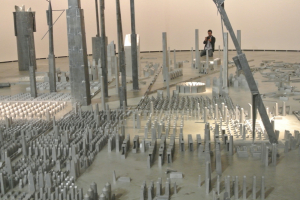It is a quirk of perception that we read this as a city. On the face of it, most of Navarro’s work is comprised of regimented obelisks.
So it’s not like any city you or I might live in. There’s no chaos, no movement and no colour. The columns are as grave as tombstones in a city of the dead.
Yet in its rational structure and the zones we can read as neighbourhoods, we recognise this as a place which the human race might yet spirit into existence.
If architects have, from the renaissance onwards, conceived of buildings in relation to the human form, Navarro throws all that out of a 100th floor window.
There is nothing humanist about this anthill. It is as heavily planned as a city conceived by some ancient people (or perhaps a child). And yet the high rise technology is 21st century.
Something ominous haunts the viewer. In this respect it is like one of de Chirico’s urban dreams. (Navarro has paid tribute to the surreal classicist.)
But no matter how sinister, this vast settlement has pull. The lighting is promising and the canyons of aluminium and zinc impress with their mystery.
There is even a bullring. And with so little else of discernible function, tauromachia assumes a huge importance in the life of this civilization to come.
One imagines it at the heart of an arcane religion. Or as a social device like the lottery in The Lottery in Babylon by Jorge Luis Borges who for some reason comes to mind.
All we know for sure is that this dystopia, which took five years to build, is a piece of timeless bad news. Navarro tells us, in great detail, the worst is still out there, somewhere.
Wall City can be seen in Art of Our Time: Masterpieces from the Guggenheim Collections, now showing at the Guggenheim Bilbao until 3 May 2015.
